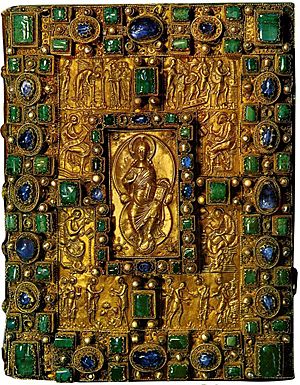Exeter Book Riddle 26 facts for kids
Exeter Book Riddle 26 is one of many old poems found in a special book called the Exeter Book. This book was written a long, long time ago, around the year 975. The riddle is written in Old English, which is a very early form of the English language. Most people who study these riddles agree that Riddle 26 is talking about a 'gospel book'.
Contents
What is Exeter Book Riddle 26?
This riddle is like a puzzle from the past. It describes something by telling you what happens to it, but it doesn't tell you its name. You have to guess! The Exeter Book contains many riddles that describe everyday objects or things in nature in a clever way. Riddle 26 is special because it tells the story of how a very important book was made.
The Mystery of the Riddle
The riddle uses clues to help you figure out what it is. It talks about being "robbed of life" and losing "hairs." It also mentions being "dunked in water" and "set in the sun." These are all steps in making something.
What Does the Riddle Say?
Here is the riddle in Old English and a simpler translation:
|
Mec feonda sum feore besnyþede, |
An enemy took my life, |
How Was a Book Made Back Then?
The riddle describes the process of making a book in the past, especially a gospel book.
- Animal Skin: The "enemy" who "robbed me of my life" is talking about an animal, usually a calf or sheep. Its skin was used to make the pages.
- Preparing the Skin: The skin was "dunked in water" and "set in the sun" to clean and stretch it. This process removed the "hairs." The skin was then scraped smooth with a "knife." This prepared the parchment or vellum for writing.
- Writing: "Fingers folded" the parchment into pages. "The bird's joy" refers to a quill pen, which was made from a bird's feather. The pen made "tracks" with "useful drops" of ink. The ink was often made from "tree-dye" (plant extracts) and "a portion of the stream" (water).
- Binding: After writing, a "hero" (the bookbinder) "wrapped me in protective boards" (wooden covers) and "covered me with hide" (leather).
- Decorating: Finally, the book was "decorated with gold" and "wrapped in wire." This describes the beautiful metalwork and jewels often used to make gospel books look very special and important.
Why Was This Book Important?
The riddle says that if people "wish to use me," they will become "healthier and more victorious," "braver in heart and happier in mind," and "wiser in spirit." This shows how highly valued these books were. Gospel books contained religious texts, like the teachings of Jesus. People believed that reading and studying them would bring wisdom, strength, and good fortune. They were seen as sacred objects, "holy itself," and very "useful to people."


